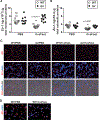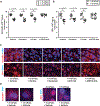Fas activation alters tight junction proteins in acute lung injury
- PMID: 30385692
- PMCID: PMC6339809
- DOI: 10.1136/thoraxjnl-2018-211535
Fas activation alters tight junction proteins in acute lung injury
Abstract
Background:The acute respiratory distress syndrome (ARDS) is characterized by protein-rich oedema in the alveolar spaces, a feature in which Fas-mediated apoptosis of the alveolar epithelium has been involved. Objective:To determine whether Fas activation increases protein permeability by mechanisms involving disruption of the paracellular tight junction (TJ) proteins in the pulmonary alveoli. Methods: Protein permeability and the expression of TJ proteins were assessed in vivo in wild-type and Fas-deficient lpr mice 16 hours after the intratracheal instillation of recombinant human soluble Fas ligand (rh-sFasL), and at different time points in vitro in human pulmonary alveolar epithelial cells (HPAEpiC) exposed to rh-sFasL Results:Activation of the Fas pathway increased protein permeability in mouse lungs and altered the expression of the TJ proteins occludin and zonula occludens-1 in the alveolar-capillary membrane in vivo and in human alveolar epithelial cell monolayers in vitro. Blockade of caspase-3, but not inhibition of tyrosine kinase dependent pathways, prevented the alterations in TJ protein expression and permeability induced by the Fas/FasL system in human alveolar cell monolayers in vitro. We also observed that both the Fas-induced increase of protein permeability and disruption of TJ proteins occurred before cell death could be detected in the cell monolayers in vitro. Conclusion:Targeting caspase pathways could prevent the disruption of TJs and reduce the formation of lung oedema in the early stages of ARDS.
Keywords: ards; innate immunity; pulmonary oedema.
© Author(s) (or their employer(s)) 2019. No commercial re-use. See rights and permissions. Published by BMJ.
Conflict of interest statement
Competing interests: None declared.
Figures








Similar articles
-
The Fas/FasL pathway impairs the alveolar fluid clearance in mouse lungs.Am J Physiol Lung Cell Mol Physiol. 2013 Sep;305(5):L377-88. doi: 10.1152/ajplung.00271.2012. Epub 2013 Jun 28. Am J Physiol Lung Cell Mol Physiol. 2013. PMID: 23812636 Free PMC article.
-
Alveolar epithelial glycocalyx shedding aggravates the epithelial barrier and disrupts epithelial tight junctions in acute respiratory distress syndrome.Biomed Pharmacother. 2021 Jan;133:111026. doi: 10.1016/j.biopha.2020.111026. Epub 2020 Nov 24. Biomed Pharmacother. 2021. PMID: 33378942 Free PMC article.
-
Inhibition of Prolyl Hydroxylase Attenuates Fas Ligand-Induced Apoptosis and Lung Injury in Mice.Am J Respir Cell Mol Biol. 2016 Dec;55(6):878-888. doi: 10.1165/rcmb.2015-0266OC. Am J Respir Cell Mol Biol. 2016. PMID: 27494234
-
Apoptosis and epithelial injury in the lungs.Proc Am Thorac Soc. 2005;2(3):214-20. doi: 10.1513/pats.200504-031AC. Proc Am Thorac Soc. 2005. PMID: 16222040 Free PMC article. Review.
-
New insights into the mechanisms of pulmonary edema in acute lung injury.Ann Transl Med. 2018 Jan;6(2):32. doi: 10.21037/atm.2017.12.18. Ann Transl Med. 2018. PMID: 29430449 Free PMC article. Review.
Cited by
-
Tight Junctions, the Epithelial Barrier, and Toll-like Receptor-4 During Lung Injury.Inflammation. 2022 Dec;45(6):2142-2162. doi: 10.1007/s10753-022-01708-y. Epub 2022 Jul 2. Inflammation. 2022. PMID: 35779195 Free PMC article. Review.
-
Ischemia-reperfusion Injury in the Transplanted Lung: A Literature Review.Transplant Direct. 2021 Jan 7;7(2):e652. doi: 10.1097/TXD.0000000000001104. eCollection 2021 Feb. Transplant Direct. 2021. PMID: 33437867 Free PMC article. Review.
-
Consumption of Endogenous Caspase-3 Activates Molecular Theranostic Nanoplatform against Inflammation-Induced Profibrotic Positive Feedback in Pulmonary Fibrosis.Adv Sci (Weinh). 2025 Feb;12(6):e2412303. doi: 10.1002/advs.202412303. Epub 2024 Dec 17. Adv Sci (Weinh). 2025. PMID: 39686776 Free PMC article.
-
Club cell protein (CC)16 as potential lung injury marker in a porcine 72 h polytrauma model.Eur J Trauma Emerg Surg. 2022 Dec;48(6):4719-4726. doi: 10.1007/s00068-022-01997-w. Epub 2022 May 21. Eur J Trauma Emerg Surg. 2022. PMID: 35596754 Free PMC article.
-
Investigating the Intercellular Communication Network of Immune Cell in Acute Respiratory Distress Syndrome with Sepsis.Comput Math Methods Med. 2022 Feb 16;2022:4586648. doi: 10.1155/2022/4586648. eCollection 2022. Comput Math Methods Med. 2022. PMID: 35222683 Free PMC article.
References
-
- Matthay MA, and Wiener-Kronish JP 1990. Intact epithelial barrier function is critical for the resolution of alveolar edema in humans. Am Rev Respir Dis 142:1250–1257. - PubMed
-
- Ware LB, and Matthay MA 2001. Alveolar fluid clearance is impaired in the majority of patients with acute lung injury and the acute respiratory distress syndrome. American journal of respiratory and critical care medicine 163:1376–1383. - PubMed
-
- Schneeberger EE, and Lynch RD 1992. Structure, function, and regulation of cellular tight junctions. The American journal of physiology 262:L647–661. - PubMed
Publication types
MeSH terms
Substances
Grants and funding
LinkOut - more resources
Full Text Sources
Research Materials
Miscellaneous
